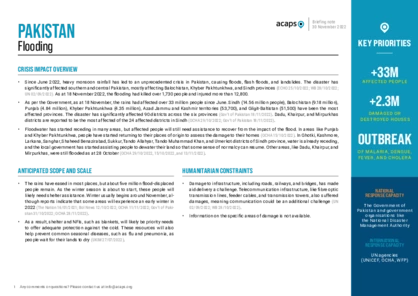Latest updates on country situation
15 April 2025
Since 1 April 2025, over 60,000 Afghans have returned from Pakistan, fearing arrest owing to increased Pakistani Government pressure. In the first five days of April, over 1,600 detentions were reported. About 1.6 million people are expected to return from Pakistan in 2025. In Afghanistan, they will likely face food, housing, and employment shortages. (UNHCR 10/04/2025, AJ 15/04/2025, WFP 13/04/2025)
08 April 2025
Since 1 April 2025, 8,900 Afghans have been expelled from Pakistan to Afghanistan after Pakistan’s October 2024 announcement of a multistage deportation plan for undocumented Afghans, with a 31 March 2025 deadline. The Pakistani Government plans to forcibly expel Afghan nationals, including refugees and asylum seekers, as part of its Illegal Foreigners Repatriation Plan. Arrests, detentions, and harassment have increased, particularly in Islamabad Capital Territory and Rawalpindi (Punjab), causing many Afghans to flee, sometimes without their belongings. In Afghanistan, returnees face unemployment, a dysfunctional healthcare system, and decreased foreign aid. Some risk persecution by the Taliban. 14.8 million were projected to face Crisis (IPC phase 3) or worse acute food insecurity from November 2024 to March 2025. The health sector is collapsing, aggravated by the US funding freeze. By 4 March, 167 health facilities had closed in 25 provinces, affecting 1.6 million people, with more expected to close by June. (DW 08/04/2025, AI 26/03/2025, UN 17/03/2025)
01 December 2024
Pakistan has been facing challenges in running a wild poliovirus type 1 vaccination programme for numerous reasons, including historical distrust of foreign healthcare providers, lack of awareness, and attacks on vaccination teams. Since the beginning of 2024, militant groups carried out at least 23 attacks against polio teams and security escorts. Until 3 December, 59 positive cases of polio had been reported within the year, much higher than 6 throughout 2023. In September alone, more than one million children missed their vaccination doses. The Government is planning to conduct the next mass vaccination programme in mid-December, with the goal of reaching 44 million children. (Govt. Pakistan 03/12/2024, AJ 01/11/2024, CNN 21/10/2024)
19 November 2024
On 18 November, Pakistan reported its 50th case of wild poliovirus type 1, a substantial increase from 6 cases in 2023, 20 in 2022, and 1 in 2021. The provinces with the most cases are Balochistan, Khyber Pakhtunkhwa, and Sindh. Low vaccination rates and vaccine reluctance pose significant challenges to public health efforts. (CNN 21/10/2024, NEOC 19/11/2024, CDC 12/09/2024)
27 August 2024
From 1 July to 22 August 2024, severe monsoon rains led to widespread flooding across multiple provinces in Pakistan. The flooding displaced 33,178 individuals in Sindh province and submerged 25 schools in Khairpur district. It also damaged 80% of the crops in the district, affecting the livelihoods of families relying on agriculture. In Balochistan province, the floods destroyed 158 houses and damaged 620, along with seven bridges and 35km of roads. The monsoon also killed 131 heads of livestock, affecting farmers' livelihoods. In refugee villages, the floods damaged water supply infrastructure, limiting clean water access and increasing the risk of diseases. In Khyber Pakhtunkhwa province, the rains killed 72 people, injured 128, damaged 874 houses, and led to the region’s first confirmed mpox case in Mardan. A flood emergency was declared in Upper Chitral district from 22–30 August. (OCHA 19/08/2024, IMC 20/08/2024, OCHA 23/08/2024)
23 April 2024
Between 12–21 April, Pakistan experienced severe weather, with heavy rainfall causing significant casualties and damage. The weather event resulted in approximately 90 fatalities, 90 injuries, and damage to over 450 schools and 3,500 homes. The Khyber Pakhtunkhwa (KP) province was hit the hardest, followed by Balochistan. Nearly 1,200 people were displaced in KP’s Lower Chitral district. The Pakistan Meteorological Department warns of continued adverse conditions, including rain, windstorms, and hail, particularly affecting Balochistan, Islamabad, Kashmir, KP, and Punjab. Provincial governments in Balochistan and KP are actively supporting the affected communities. (OCHA 22/04/2024, Al Jazeera 16/04/2024, ECHO 23/04/2024)
13 March 2024
Since 26 February 2024, heavy snowfall and rain have been causing floods, landslides, and destruction in northern and western Pakistan. As at 5 March, 40 people died and 62 were injured. The adverse weather conditions led to the destruction of 80 houses and damage to 554. As at 12 March, nine people died and 3,200 houses were damaged in Balochistan. Thousands of people have been displaced, but numbers are yet to be confirmed by official sources. The national and provincial governments are providing food, tents, and cash in the affected areas. Persistent snowfall and rainfall have resulted in the blockade of key highways, roads, and bridges in Balochistan and Khyber Pakhtunkhwa, causing access constraints. The adverse weather has also caused internet outages, which are likely hampering the flow of information from the affected regions. Pakistan has not yet recovered from the 2022 flood that left 20.6 million people in need of humanitarian assistance, with 1.5 million people still displaced in flood-affected districts. (ECHO 06/03/2024, RFERL 05/03/2024, Samaa TV 13/03/2024)
current crises
in
Pakistan
These crises have been identified through the INFORM Severity Index, a tool for measuring and comparing the severity of humanitarian crises globally.
PAK001 - Complex crisis
Last updated 17/03/2025
Drivers
Displacement
Conflict
Crisis level
Country
Severity level
4 High
Access constraints
4.0
PAK004 - Kashmir conflict
Last updated 17/03/2025
Drivers
Conflict
Crisis level
Country
Severity level
Access constraints
2.0
Analysis products
on
Pakistan
09 October 2024
Pakistan: 2024 monsoon floods
DOCUMENT / PDF / 330 KB
In 2024, Pakistan has experienced an exceptionally intense monsoon season (typically from July–September), leading to extensive damage and casualties. In some parts of the country, rainfall levels have reached up to 318% above normal.
30 November 2022
Pakistan: flooding
DOCUMENT / PDF / 2 MB
Since June 2022, heavy monsoon rainfall has led to an unprecedented crisis in Pakistan, causing floods, flash floods, and landslides. The disaster has significantly affected southern and central Pakistan, mostly affecting Balochistan, Khyber Pakhtunkhwa, and Sindh provinces .
31 August 2022
Pakistan: Floods
DOCUMENT / PDF / 219 KB
Since 14 June, Pakistan has been experiencing an abnormal monsoon rainfall season, close to three times more intense than the past 30-year average. As at 29 August, the floods had killed more than 1,000 people, injured 1,600, and affected more than 33 million (equivalent to nearly 15% of the total population).
02 February 2022
Pakistan: Floods
DOCUMENT / PDF / 207 KB
Heavy rainfall, heavy snowfall, and sub-zero temperatures hit Balochistan province between 4–10 January, causing flash floods and landslides. The floods affected over 17,300 people in 41 villages within the Gwadar district and damaged or destroyed more than 500 houses.






